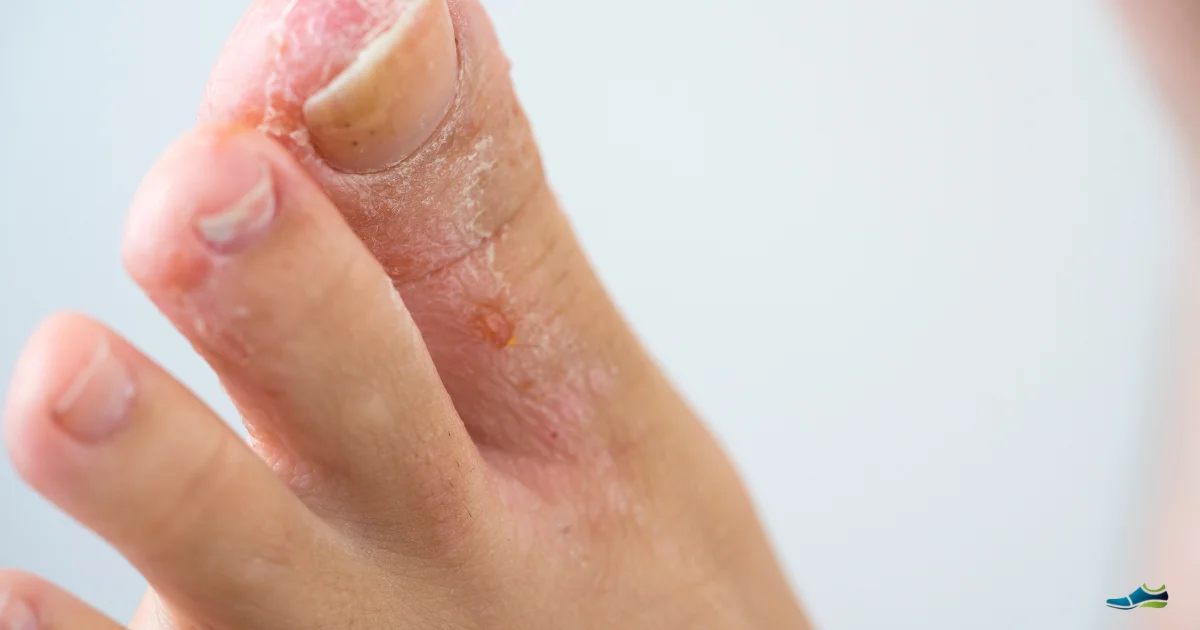Itchy, peeling skin between the toes? You’re not alone. Athlete’s foot is one of the most common foot infections worldwide. The good news: with the right treatment and footwear habits, you can calm it quickly and reduce the chance of it coming back.
This guide explains the treatment options, causes, fast relief strategies, prevention tips, and how your shoes and socks play a major role in keeping your feet fungus-free.
The treatment for athlete’s foot usually starts with over-the-counter antifungal creams, combined with good foot hygiene to keep the skin dry and prevent reinfection.
📌 At a Glance
All the key facts on Athlete’s Foot in one place — no scrolling, no searching.
Jump straight to 20 Common Questions & Answers.
What Is Athlete’s Foot?
Athlete’s foot (tinea pedis) is a contagious fungal skin infection that thrives in warm, damp conditions. It usually begins between the toes but can spread to the soles, toenails, and even hands if untreated.
If your foot pain isn’t limited to this one condition, our Complete Guide to Foot Pain Relief walks you through all the main causes, treatments, and footwear tips to keep every step more comfortable.
Causes of Athlete’s Foot
- Fungi (dermatophytes) growing on moist, sweaty skin
- Wearing tight or non-breathable shoes
- Walking barefoot in communal showers, pools, or gyms
- Re-using damp socks or shoes without drying properly
- Sharing towels, shoes, or bedding with an infected person
Symptoms of Athlete’s Foot
- Itchy, stinging, or burning skin between the toes
- Peeling, cracked, or reddened skin
- Small blisters that may ooze
- Dry, scaly skin on soles or sides of the feet
- Thickened or discoloured toenails if the fungus spreads
Fast Relief From Athlete’s Foot
- Over-the-counter antifungals – creams, sprays, or powders used consistently for 2–4 weeks (and continued for a week after symptoms clear).
- Keep feet dry – towel between the toes; use a separate foot towel to stop spreading fungus.
- Change socks often – at least daily; twice if sweaty. Opt for cotton blends or moisture-wicking socks.
- Disinfect shoes – antifungal sprays or UV shoe devices stop re-infection.
- Avoid scratching – scratching spreads fungus and risks secondary infection. Soothing powders or sprays can ease the itch.
Footwear Habits to Stop Athlete’s Foot Coming Back
- Rotate shoes daily — allow at least 24 hours to air out
- Choose breathable materials — mesh or leather let moisture escape
- Moisture-wicking socks — avoid nylon or synthetic that traps heat
- Sandals or flip-flops in communal showers/pools
- Never share shoes — fungal spores can live inside for weeks
Prevention Tips
- Wash feet daily and dry thoroughly (especially between toes)
- Change socks after exercise or dampness
- Keep toenails short and clean
- Disinfect shared bathroom floors
- Treat toenail fungus early to prevent reinfection
- Athlete’s foot can inflame toes, making ingrown nails worse
When to See a Doctor
- If OTC treatment fails after 4 weeks
- When cracks, pus, or spreading infection appear
- If you have diabetes or poor circulation
- If toenails are thickened or painful (fungal nails often require longer treatment)
Recurring athlete’s foot can often lead to fungal nail infections or even painful blisters if left untreated.
20 Questions on Athlete’s Foot
Q: What is athlete’s foot?
A: A fungal skin infection that thrives in warm, damp conditions.
Q: Where does it usually start?
A: Most often between the toes, but it can spread to soles and nails.
Q: What are the key symptoms?
A: Itching, peeling skin, redness, and sometimes blisters or cracks.
Q: What’s the first-line treatment?
A: Over-the-counter antifungal creams or sprays, used daily for at least 2 weeks.
Q: Should I keep applying treatment after symptoms clear?
A: Yes, continue for a week beyond visible healing to prevent recurrence.
Q: Can my shoes cause reinfection?
A: Yes — fungi can live in shoes. Rotate pairs and disinfect regularly.
Q: Which socks are best?
A: Moisture-wicking socks that keep feet dry; change mid-day if damp.
Q: Are powders or sprays inside shoes useful?
A: Yes, they help keep interiors dry and reduce reinfection risk.
Q: Should I wear flip-flops in communal showers?
A: Absolutely — it’s the best way to protect against infection.
Q: Can athlete’s foot spread to toenails?
A: Yes, untreated cases often lead to fungal nail infections.
Q: Is athlete’s foot contagious?
A: Very — avoid sharing towels, socks, or shoes.
Q: Can tight shoes cause athlete’s foot?
A: Not directly, but they trap heat and moisture which encourages fungi.
Q: What if cracks appear between toes?
A: Keep the area dry, apply antifungal cream, and add barrier cream around the edges.
Q: Can blisters occur with athlete’s foot?
A: Yes, especially in the inflammatory type. Seek help if severe.
Q: Do children get athlete’s foot?
A: Yes, though hygiene habits and treatment are key for managing it.
Q: Can I keep exercising?
A: Yes, just treat consistently and change socks after workouts.
Q: Any laundry tips?
A: Wash socks/towels at 60°C during outbreaks to kill fungus.
Q: Do deodorising insoles help?
A: Yes, if breathable — but always rotate and dry shoes properly.
Q: What’s the quick fix trio?
A: Antifungal cream daily + breathable shoes + midday sock change.
Q: When should I see a clinician?
A: If there’s no improvement after 4 weeks, if toenails are affected, or if you have diabetes.
📌 Summary
Athlete’s foot is common, contagious, and stubborn — but with consistent treatment and better footwear habits, you can control it and stop it coming back. Keep your feet clean, dry, and well-ventilated, and don’t forget to rotate shoes and wear sandals in communal areas.

